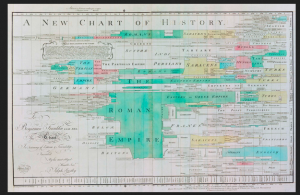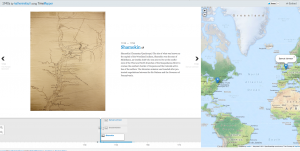Contextual Research, or, Meanwhile, in the rest of the 1740s

In this next section of the course, we will be thinking about how to map time. As a help, read Anthony Grafton’s Introduction to Cartographies of Time (Princeton,2009).
Assignment Objective: Contextualize the experience of the Moravian missionaries in the 1740s within a broader historical landscape that is *not* focused on the Moravian mission, but on events and trends occurring throughout the world during the same period.
We will be crowdsourcing the contextual research for the 1740s. The visualization tool we will be using is called Timemapper and I have already set up an instance for our course.
Its URL is http://timemapper.okfnlabs.org/katherinefaull/1740s#faq-publish

In order to populate more slides we need to gather specific information. Once you have gathered the information you will submit it here
First, choose a research category from a pre-determined list; for example,
http://en.wikipedia.org/wiki/1740s
- Science
- Celsius proposes the centigrade scale (1741)
- Literature
- June 1746 –Samuel Johnson is contracted to write his
Dictionary of the English Language
- Politics
- 1740-1748 War of the Austrian Succession
- Religion
- 1741-49 The First Great Awakening in the Colonies
- Geographical exploration
- Albus Bering explores the coast of Alaska (1741)
- Rediscovery of the ruins of Pompeii (1748)
- Philosophy
- 1745-Rousseau begins collaboration on the Encyclopèdie in Paris
- Colonial expansion
- Slave trade–beginning of the peak of the slave trade until the mid-19th century
- Events: American
- Events: European
- 1741 December 11 – a “Fire-ball” and explosion heard over southern England, about 11 a.m. “a countryman … saw a flash of Lightening Before he heard the Noise … The sound was double … a Ball of Fire … took its Course to the East … over Westminster … it divided into Two Heads [and] left a Train of Smoke … which continued ascending for 20 minutes”.[1]
- Events: Asian
- Events: African
- Events: Australian
Then write an equivalent of an encyclopedia entry about your topic, incorporating text, specific reference to place and time, and one evocative contemporary image (map, painting, sketch). Students incorporate their entry into a master Google spreadsheet that will then be used to generate a Timemapper timeline.
Examples:
http://timemapper.okfnlabs.org/katherinefaull/moravians#0
https://docs.google.com/a/bucknell.edu/spreadsheet/ccc?key=0Avv8yVuozRJ1dFBSSnQtZFBRVkdDOG9vMXZsajNETGc&usp=drive_web#gid=0
http://timemapper.okfnlabs.org/katherinefaull/rousseau-and-kant-time-mapper
If you want to delve further into the contemporary events you might want to look at the newspaper databases
http://researchbysubject.bucknell.edu/c.php?g=25610&p=156731
and Pennsylvania Gazette
http://www.accessible-archives.com/collections/the-pennsylvania-gazette/)
http://bucknell.worldcat.org/oclc/2222971
—————————–
We will be building out this Time Mapper
http://timemapper.okfnlabs.org/katherinefaull/1740s#faq-publish
In order to populate more slides we need to gather specific information. Once you have gathered the information, submit data here
———————————-
Another form of visualizing time that is very specific can be found with Timeglider
This is looking at events on the micro level. You can enter the dates of your page of the Powell Diary here on this time line.
http://timeglider.com/authoring
You all have accounts as my students.
Your screen name is [humanitiesnow-firstname] password=shamokin